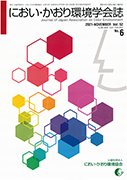
- Issue 6 Pages 312-
- Issue 5 Pages 266-
- Issue 4 Pages 202-
- Issue 3 Pages 148-
- Issue 2 Pages 104-
- Issue 1 Pages 2-
- |<
- <
- 1
- >
- >|
-
Takamichi NAKAMURA2021 Volume 52 Issue 6 Pages 312
Published: November 30, 2021
Released on J-STAGE: December 01, 2021
JOURNAL FREE ACCESSDownload PDF (148K) -
Toyoaki ISHIKAWA2021 Volume 52 Issue 6 Pages 313-320
Published: November 30, 2021
Released on J-STAGE: December 01, 2021
JOURNAL FREE ACCESSThe word “Olfactory Dysfunction” is now widely recognized as one of the symptoms of the novel coronavirus or its after effects. Accordingly, the demand for more simplified olfactory testing is increasing. The beginning of the article will give the brief overview about olfactory dysfunction, followed by the story behind the development of the simple olfactory test kit, co-developed with the Juntendo University and by the knowledge that our company has obtained over the course of manufacturing olfactory products. The last part of the article will share the common story that anyone involved in manufacturing olfactory products can relate themselves to. Please relax and enjoy reading.
View full abstractDownload PDF (1167K) -
Yoichi MIDORIKAWA2021 Volume 52 Issue 6 Pages 321-330
Published: November 30, 2021
Released on J-STAGE: December 01, 2021
JOURNAL FREE ACCESSWhen fragrances and essential oils were added to the hygiene agent based on hydrated lime produced from discarded seashells and other materials in order to give it a cool, refreshing odor, the odor did not turn out to be the odor imagined and changed to a putrid odor. Hydrated lime is characterized by its strong base and porous nature, and it has a bactericidal and deodorizing function, but it is thought that this property is incompatible with organic compounds. If hydrated lime can be given an aroma, it can be expected to have a masking effect in addition to sterilization and deodorization by adsorption, expanding the possibilities of products for body and house cleaning. If we can use the blessings of nature appropriately in our modern lives, we can expect to create an environment for a sustainable society.
View full abstractDownload PDF (2583K) -
Daiki KAWAMURA2021 Volume 52 Issue 6 Pages 331-336
Published: November 30, 2021
Released on J-STAGE: December 01, 2021
JOURNAL FREE ACCESSAerobic treatment is mainly used for Bioremediation of oil contaminated soil. It is important that oxygen supplying for aerobic treatment. In case oxygen supplying can be not uniformly, it turn to anaerobic environment. In anaerobic condition, anaerobic degradation is proceeded, then, anaerobic bad odors come into issue. When the anaerobic bad odor diffuse, our work environment will suffer deterioration.
This report describes the effects of oil concentration on anaerobic odors and the results of examining ways to proceed with treatment without diffusing odors.
View full abstractDownload PDF (1362K) -
Akinori IGUCHI2021 Volume 52 Issue 6 Pages 337-343
Published: November 30, 2021
Released on J-STAGE: December 01, 2021
JOURNAL FREE ACCESSIn Akiha-ku, Niigata City, which used to have one of the largest oil fields in Japan, crude oil is still produced in some areas and rivers. In Japan, it is relatively rare to find a naturally flowing oil field in the suburbs of a city, and the flowing oil is expected to affect the microbial ecosystem of the river and the soil in the vicinity. In addition, elucidation of the ecosystem of the environment will provide important information for the future biological treatment of crude oil (environmental remediation). In this manuscript, we introduce this area, which was once known as “the city of oil”, and the analysis and exploration of indigenous microorganisms residing in the crude oil production points that the author has been conducting.
View full abstractDownload PDF (1837K)
-
Atsuko OHNO, Yukihiro YADA2021 Volume 52 Issue 6 Pages 344-357
Published: November 30, 2021
Released on J-STAGE: December 01, 2021
JOURNAL FREE ACCESSThe purpose of this study was to clarify the psychophysiological effects of second flush Darjeeling tea aroma. First, the preference for second flush Darjeeling tea aroma and the impressions of the aroma were evaluated. Next, an integrative physiological evaluation of autonomic and central nervous system activities was performed along with psychological evaluation. Inhalation of second flush Darjeeling tea aroma significantly reduced “subjective stress,” “depression/anxiety,” and “hostility.” “Invigoration” and “inactivity” increased significantly, suggesting a sedative effect on psychology. Physiologically, the miosis rate and peripheral skin temperature increased significantly after inhalation of second flush Darjeeling tea aroma, suggesting that sympathetic nerve activity was suppressed and parasympathetic nerve activity became dominant. Furthermore, a significant decrease in blood flow was observed in the prefrontal area of the brain, suggesting a sedative effect on central nervous system activity. While second flush Darjeeling tea aroma had a sedative effect on the psychophysiological level, the physiological effects on the autonomic nervous system activity was not correlated with the preference of the aroma or its psychological effects.
View full abstractDownload PDF (1786K)
-
Tadaaki SATOU, Yuka NEMOTO, Shingo TSUKADA, Shigeyuki KEZUKA, Makoto T ...2021 Volume 52 Issue 6 Pages 358-360
Published: November 30, 2021
Released on J-STAGE: December 01, 2021
JOURNAL FREE ACCESSScent is one of the most important factors associated with Kampo medications. However, the dry extract formulation process can lead to a significant loss in scent. The present study utilized cinnamaldehyde as an indicator of the scent component as a method of investigating potential decreases in the scent during the preparation process. The results indicated that the optimum concentration temperature was 52-55°C and that the crude drug involved in the cinnamaldehyde reduction was the apricot kernel.
View full abstractDownload PDF (263K)
- |<
- <
- 1
- >
- >|